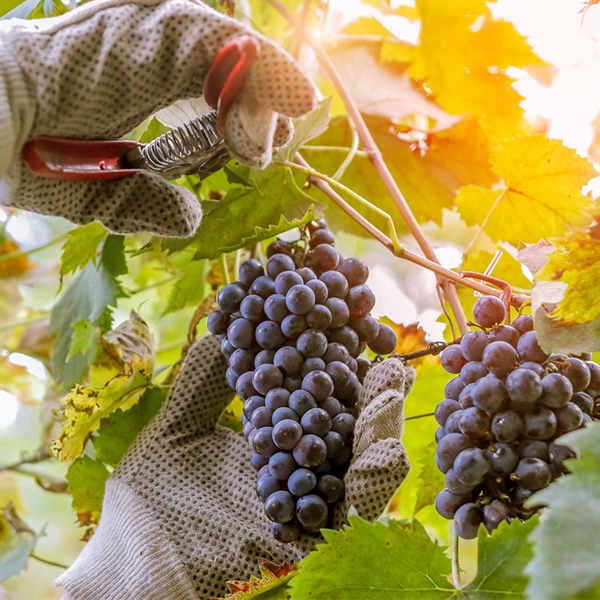Written By: Nan McCreary
You can feel it in the air: the electricity of dozens of workers heading into the vineyards with their buckets and baskets, the aroma of freshly picked grapes, and the sounds of trucks carrying aluminum bins on their way to the winery.
It’s harvest, and it’s a thrilling time for grape growers who have spent the last year nurturing their vines in preparation for a successful crop.
In the northern hemisphere, harvest runs from August to October, depending on the ripening rate of different grapes. The season begins with veraison, the transition from berry growth to berry ripening. This is a crucial moment in the grapevine’s annual lifecycle.
Red varieties turn from green to red, while whites become more translucent. At this stage, grapevines begin to re-channel their energy to the grapes. Acid levels fall and sugar levels rise until the grapes are perfectly in balance and ready to be harvested.
Determining that “magical moment” for harvest is one of the most important decisions a vintner has to make: Pick too early and the grapes may be overly acidic and tannic. Pick too late and sugar levels may be too high, resulting in a sweet, flabby wine.
In the weeks leading up to harvest, winemakers test the grapes for sugar ripeness (measured in brix) and taste. They also examine for physiological ripeness, a measurement of phenolic compounds that add layers of flavor, color and texture to wine. The one variable they can’t predict, either by lab or by taste, is Mother Nature: A heat wave or rain showers can force the vineyard crew to move up or postpone picking.
Once “the date” is selected, it’s all hands-on deck. Traditionally, grapes are harvested by hand as opposed to machine-harvesting, which is common with many mass-produced wines. Hand harvesting allows trained workers to be very selective: They can distinguish between ripe and underripe grapes, and clusters that show signs of rot or damage.
Increasingly, winemakers are choosing to harvest their grapes at night or at dawn when it’s cooler. Lower temperatures keep sugar levels stable and help preserve aromatics and flavors.
To beat the heat, as soon as grapes are picked, they are rushed to the winery, where they are sorted for quality and then crushed and destemmed in preparation for fermentation.
Working harvest is not for the faint of heart.
The shifts can be grueling, with long hours, high temperatures and demanding physical work. But those who have participated say it is a labor of love. Dennis Oetting, (a member of the Houston Livestock Show and Rodeo Wine Events and Wine Garden Committees) recently worked the harvest of Blanc Du Bois grapes for Houston’s Nice Winery at their vineyard in Anderson, Texas.
On a hot July morning, Oetting, and approximately 80 other volunteers, started working at 6 a.m. and picked grapes until 11 a.m on their hands and knees. When they finished, they went to Saddlehorn Winery to watch the de-stemming and crushing process and enjoy a barbecue lunch. “I was amazed at how many people showed up and volunteered,” Oetting said. “It was a fun time, being with other wine enthusiasts, learning more about grapes and enjoying leisure time at the end. It all made for a remarkable day.”
If you’re so inclined, you too can work a harvest! In Texas, many Hill Country wineries seek volunteers for a day of grape picking, stomping, tasting and harvest t-shirts.
Closer to home, wineries besides Nice, including Messina Hof (in Bryan), Pleasant Hill Winery (near Brenham) and Bernhardt Winery (in Plantersville) offer “crush for fun” events for the entire family.
For the grapes, harvest is only the beginning of their journey. Once at the winery, they go from fermentation to aging to bottling and, finally, to the tasting room, and the package store or bar.
Ultimately, these grapes end up in your glass. The next time you open a bottle of wine, think about this: Someone picked those 75 to 100 grapes, or one cluster, necessary to fill your glass, and over 400 grapes to produce that bottle. Now that’s a lot of grapes picked for your drinking pleasure! But not to worry: To the one with the basket and the grape-stained hands, it’s all in a day’s work.
For more articles like this and all things wine, join our Rodeo Uncorked! Facebook group to connect with other wine enthusiasts.



